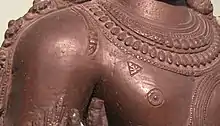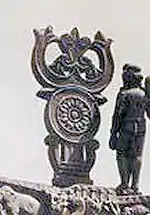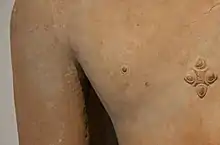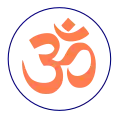
The Shrivatsa (Sanskrit: श्रीवत्स; IAST: Śrīvatsa, lit. 'Beloved of Shri')[1] is an ancient symbol, considered auspicious in Hinduism and other Indian religious traditions. It is said that the Shrivatsa symbol appears on the chest of an avatar of Vishnu when he is chosen to be Vishnu's incarnation[2]
Hinduism
Origin
Shrivatsa means "Beloved of Shri", an epithet of Vishnu, and a reference to his consort, the goddess Lakshmi, also called Shri.[3] It is a mark on the chest of Vishnu, where his consort is described to reside.
The Bhagavata Purana explains the origin of this mark. The story goes that a number of maharishis once gathered on the banks of the river Sarasvati to perform a yajna. A dispute arose among these sages regarding the superiority of the members of the Trimurti: Brahma, Vishnu, or Shiva. The sage Bhrigu was appointed to discover the truth of this matter, and undertook this task by travelling to the abodes of these deities. He felt disrespected by Brahma when the latter was offended by the fact that he had taken his seat on a stool that was not offered to him. He grew anxious when Shiva rose to embrace him, which offered the deity offence as well. Bhrigu then journeyed to the abode of Vishnu:[4]
Bhṛgu then turned his steps to Vaikuṇṭha, the abode of Mahāviṣṇu. There he saw Mahāviṣṇu in a deep slumber. Seeing Mahāviṣṇu whose task is the preservation of the world, sleeping like an irresponsible person, Bhṛgu gave him a kick on his breast. Viṣṇu who sprang up suddenly, saw Bhṛgu standing before him. He begged pardon of the sage. He declared that he would carry Bhṛgu’s footprint permanently on his chest as a sign of his repentance for having shown disrespect to the Maharṣi. This foot-print still remains on Viṣṇu’s chest and is known by the name "Śrīvatsa". In this way, the Munis came to the conclusion that Mahāviṣṇu is the noblest of the Trimūrtis.
In the legend of Tirumala, Vishnu's consort, Lakshmi, is offended by the fact that the sage had kicked her beloved, as well as insulted the region of her husband she is associated with the most. She furiously descends upon the earth, where Vishnu finds her as Padmavati, and remarries her in his avatar of Srinivasa.
It is said that the tenth avatar of Vishnu, Kalki, will bear the Shrivatsa mark on his chest.
Shrivatsa is one of the names of Vishnu in the Vishnu Sahasranamam.
The symbol offers the deity another epithet, Śrīvatsalāñcchana, which translates to, "He who has the mark or scar of Śrīvatsa on his chest".[5]
In popular culture
Shrivatsa is a popular name in Andhra Pradesh, Telangana, Tamil Nadu and Karnataka.
Historical symbolism
In South India, in the bronze sculptures made after circa 10th century, the Shrivatsa symbol is shown as an inverted triangle on the right chest of Vishnu, and his various incarnations.[6]
Buddhism

In Buddhism, the śrīvatsa is said to be a feature of the tutelary deity (Tibetan: yidam) Mañjuśrī the Youth (Skt: Mañjuśrīkumārabhūta).[7]
In Tibetan Buddhism, the śrīvatsa (Tib: དཔལ་བེའུ་, Wyl: dpal be'u) is depicted as a triangular swirl or an endless knot.[3] In the Chinese tradition, Buddhist prayer beads are often tied at the tassels in this shape.
In some lists of the 80 secondary characteristics, it is said that a Buddha's heart is adorned with the śrīvatsa.[8]
Jainism

In Jain iconography, Shrivatsa often marks the chest of the Tirthankara image.[9] It is one of the Ashtamangala (eight auspicious symbols) found in Jainism. The canonical texts such as Hemchandra's Trīṣaṣṭiśalākāpuruṣacaritra and Mahapurana mentions it as one of the Ashtamangalas.[10] Acharya Dinakara explains in his medieval work that the highest knowledge emerged from the heart of Tirthankaras in the form of Shrivatsa so they are marked as such.[11] In North Indian Jain sculptures of the early centuries, it is marked in the centre of the chest.[6]
Other uses

The Shrivatsa is the symbol of Rakhine State and the Rakhine people of Burma.
See also
Notes
- ↑ Hinnells, John R. (25 March 2010). The Penguin Handbook of the World's Living Religions. Penguin UK. p. 284. ISBN 978-0-14-195504-9.
- ↑ Sarat Chandra Das (1902). Tibetan-English Dictionary with Sanskrit Synonyms. Calcutta, India: Bengal Secretariat Book Depot, p. 69
- 1 2 The Handbook of Tibetan Buddhist Symbols, p. PA11, at Google Books
- ↑ www.wisdomlib.org (28 January 2019). "Story of Bhṛgu". www.wisdomlib.org. Retrieved 8 August 2022.
- ↑ www.wisdomlib.org (28 January 2019). "Story of Viṣṇu". www.wisdomlib.org. Retrieved 8 August 2022.
- 1 2 "Page 51 - ICONOGRAPHY OF THE JAIN IMAGES IN THE GOVERNMENT MUSEUM CHENNAI". Archived from the original on 15 September 2017. Retrieved 15 September 2017.
- ↑ Alex Wayman, "Chanting the Names of Manjusri" 1985, p. 94
- ↑ Padmakara Translation Group (translator)) (2018). "The Transcendent Perfection of Wisdom in Ten Thousand Lines". 84000: Translating the Words of the Buddha. Retrieved 25 December 2019.
{{cite web}}:|last1=has generic name (help) - ↑ Red sandstone figure of a tirthankara
- ↑ Jain & Fischer 1978, p. 15, 31.
- ↑ Rai Govind Chandra (1 December 1996). Indian symbolism: symbols as sources of our customs and beliefs. Munshiram Manoharlal Publishers. p. 37. ISBN 978-81-215-0081-4.
References
- Jain, Jyotindra; Fischer, Eberhard (1978), Jaina Iconography, Part 12- Iconography of religions: Indian religions, BRILL, ISBN 978-9004052598
Further reading
- Sutton, Nicholas (2000). Religious doctrines in the Mahābhārata. Motilal Banarsidass. p. 153. ISBN 9788120817005.
